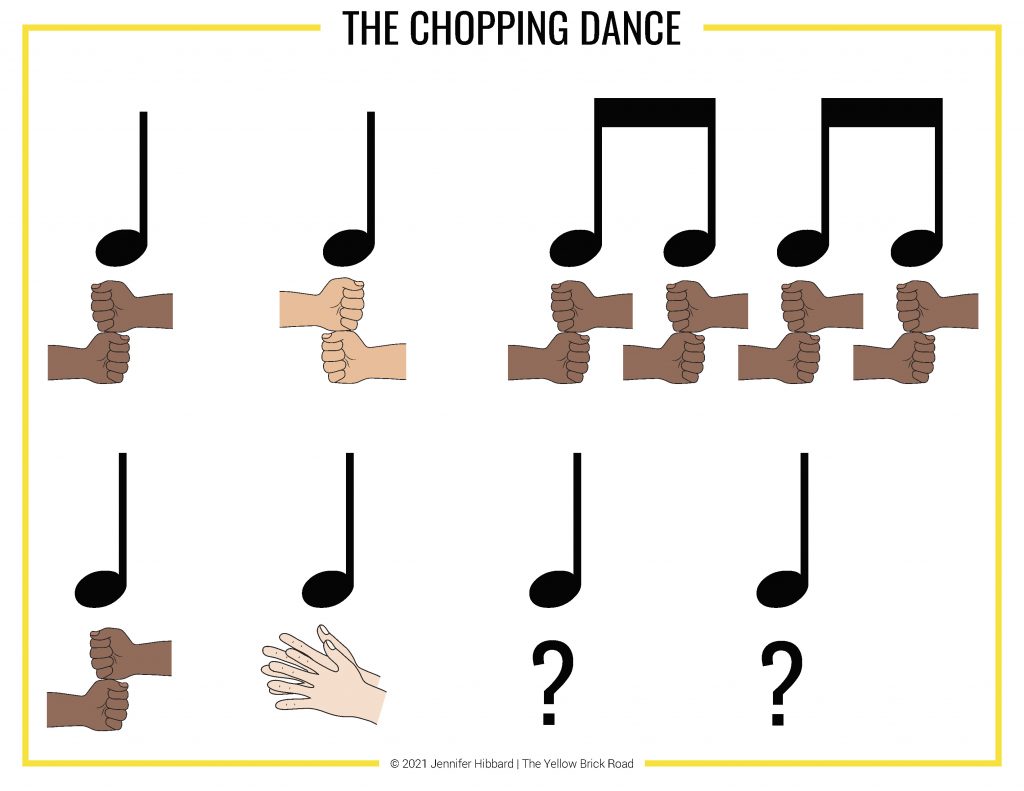TikTok is an app that showcases short videos, often set to music. 80% of TikTok users are between the ages of 16-34. And 26% are between the ages 25-44. That’s me! Due to the app’s overwhelming popularity with teenagers, it makes perfect sense to find ways to infuse it into the general music classroom.
WHAT IS IT?
TikTok is an app featuring short videos created by its users from all over the world. During my time on TikTok, I’ve seen a variety of both educational and entertaining content. Here are just a few examples of the topics I’ve seen addressed on TikTok:
- linguistics
- music education
- pets
- baking
- science
- music
- horticulture
Just like any other social media, TikTok conforms to your specific interests. My For You Page (FYP), consists mostly of music teachers, pets doing hilarious things, role-playing comedians, and other randomness. The more you like and follow, the more your FYP will suit you.
USING MUSIC FROM TIKTOK TRENDS: THE CHOPPING DANCE
Remember the obsession with sea shanties earlier this year? That was due to TikTok. TikTok has the power to make all kinds of music go viral, and the music is gloriously diverse. I’ve found hip hop, Gregorian Chant, bluegrass, barbershop quartets, jazz, original songs from TikTok users, Indigenous music from North America, and more.
Of course, to grab your students’ attention, it’s best if you find music that is from a TikTok trend that’s gone viral. Today, I’m going to share a lesson idea that involves the Chopping Dance. The Chopping Dance uses music from The Magic Bomb by Vietnamese musician Hoàng Read, which you can listen to HERE. It’s become part of a “Questions I Get Asked” trend on TikTok. Users will respond to questions they’re asked, while performing hand motions to a small portion of the song.
I chose the Chopping Dance for today’s post because the rhythms are incredibly simple. The rhythm pattern used for the dance is below:

The motions of The Chopping Dance have some slight variations depending on the video. I created a visual showing the most common motions, while leaving the last two beats blank. When students create independently, I think it’s a good idea to start with some solid parameters, so that they aren’t left wondering where to begin. Plus, it helps to build their confidence when it’s time to try more independent creation projects.
To start, they only need to create motions for the final two beats. From there, you could have them expand on that to create new motions for the other beats as well. Click the Download button below to get the visual for The Chopping Dance. I used clipart from Dancing Crayon Designs to create the graphic.

CHOPPING DANCE EXAMPLES
The Chopping Dance isn’t just about motions, the purpose behind the video is for users to answer questions they are commonly asked. Thankfully, I have some creative music teacher friends who have created their own videos and are letting me share them here.
The video below shows my friend Anne from Anacrusic doing The Chopping Dance while answering questions she gets asked about her teaching philosophy. Be sure to check out Anne’s amazing podcast HERE!
This next video is by my friend Rachel from Music with Mrs. Tanenblatt, where she shares questions she gets as a music teacher. Be sure to check out Rachel’s Instagram HERE.
QUESTIONS STUDENTS ARE ASKED
Before starting this lesson, have your students write out a list of questions they’re often asked. It’ll not only suck them into the lesson immediately, but it’ll be a lesson for you on their interests. Here are some examples you might use:
- How old are you?
- What grade are you in?
- What’s your favorite subject?
- What do you want to do when you get older?
- What are your favorite games to play?
- How many pets do you have?
You could fill out this lesson by having students create an entire TikTok on their own, or you can simply have them do these steps as part of the exercise. After all, lessons aren’t always about the end goal, sometimes it’s just about the process.
RHYTHMIC DICTATION
Using music from TikTok is an easy way to get your students invested in rhythmic dictation. Keep in mind that rhythmic dictation can include a variety of notations. Perhaps your students can begin by writing out the short and long sounds they hear via dots and dashes. Or maybe your students can use manipulatives to show what they’ve heard.
The Chopping dance is a fantastic example of short and long sounds, but there are more music trends that would be fun for your students to dictate. For example, the “Bongo Cha Cha Cha” trend includes a snippet of the song by Catarina Valenta, and includes simple syncopation. You can listen to the song HERE. The more you scroll TikTok (it’s hard to stop once you’ve started) the more opportunities you’ll find to include the accompanying music in your classroom.
